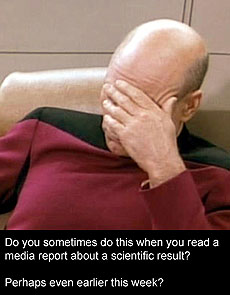Epic facepalm
 |
| A recent statement by physicist Stephen Hawking has been misrepresented in the extreme. Let's take a look at what he really meant.
|
Read the full column on stability and the Higgs boson.
If you're a science enthusiast, this week you have likely encountered outlandish headlines invoking Stephen Hawking, the Higgs boson and the end of the universe. I hope you had the presence of mind to react as the famous actor in the picture did. Let's start with the answer first. The universe is safe and will be for a very long time — for trillions of years. This story as widely reported by the media is a jaw-dropping misrepresentation of science.
To understand how abominably Hawking's statement was twisted, first we need to understand the statement. To paraphrase just a little, Hawking said that in a world in which the Higgs boson and the top quark have the masses that scientists have measured, the universe is in a metastable state.
So let's take those pieces one at a time. What does "metastable" mean? Basically, metastable means "kind of stable." So what does that mean? Let's consider an example. Take a pool cue and lay it on the pool table. The cue is stable; it's not going anywhere. Take the same cue and balance it on your finger. That's unstable; under almost any circumstances, the cue will fall over. So the terms stable and unstable are easy and have familiar, real-world analogues. The analogy for a metastable object is a barstool. Under almost all circumstances, the stool will sit there for all eternity. However, if you bump the stool hard enough, it will fall over. When the stool has fallen over, it is now more stable than it was, just like the pool cue lying on the table.
Now we need to bring in the universe and the laws that govern it. Here is an important guiding principle: The universe is lazy — a giant, cosmic couch potato. If at all possible, the universe will figure out a way to move to the lowest energy state it can. A simple analogy is a ball placed on the side of a mountain. It will roll down the mountainside and come to rest at the bottom of the valley. This ball would then be in a stable configuration. The universe is the same way. After the cosmos was created, the fields that make up the universe should arrange themselves into the lowest possible energy state.
There is a proviso. Just as on a slope of a mountain, where there may be a little valley part way up the hill (above the real valley), it is possible that there could be little "valleys" in the energy slope. As the universe cooled, it could be that it might have been caught in one of those little valleys. Ideally, the universe would like to fall into the deeper valley below, but it could be trapped. This is an example of a metastable state. As long as the little valley is deep enough, it's hard to get out of. Indeed, using classical physics, it is impossible to get out of it.
Read more
—Don Lincoln
|